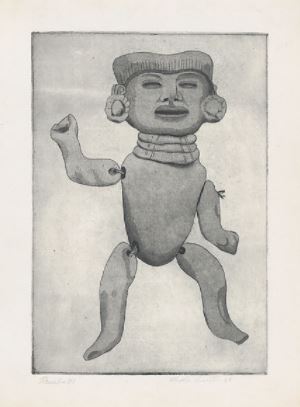GIULIA DEVAL: XIPE – ON BEING NEPANTLERAS
ZUIHITSU
QUIRKY THOUGHTS COLLECTION
Essays, personal stories and curiosities from our guest fem人le contributors
GIULIA DEVAL: XIPE – ON BEING NEPANTLERAS

I drew this conceptual map together with Ivan Bringas, a Mexican improviser guitarist with whom I made up XIPE.
It is very much possible that the connections that each of us weaves between one word and another are not the same as they are rooted in different cultures and experiences, but that is the beauty of it.
It is with this same spirit that we give this map to the readers: weaving their own connections and telling their own story.
Last July, we were in residence at Hangar, a research center for the arts in Barcelona. We were there with the task of curating the Audio Formal Programme and developing our duo project, which straddles improvisation and many other things, since what we share is a very strong interest in music of oral tradition and anthropology, or rather, in that new anthropology that moves beyond the human, towards the animal, towards forests, towards mushrooms…
Because of the covid, that edition of Audio Formal did not take place, but much of the research we did during the residency is within this map. The title we came up with for the programme, which included ALMARE collective and Lithuanian performer Arma Agharta, was Mytho(sound)poesis.
Myth is a form of shared orality, it can evolve continuously and never assumes the prescriptive and univocal status of the written word.
For this reason it is akin to all processes that contemplate practices of freedom such as improvisation, the proliferation of stories, the integration of multiple points of view.
We wrote: Mytho(sound)poesis draws a framework focused on the relationship between sound practices and the production of worlds, people and communities to come – often drawing on residual and emerging cultures – in a co-extensive vision between imaginary pasts and futures.
Following the cancellation of the final concert, Hangar decided to support us by giving us a financial contribution for a record production, and – here we are ! – a few months later with our first album, Nepantleras, produced by a musician who is an absolute reference for us: Elliott Sharp…and released by his label zOaR Records.
Nepantla means several things: first of all, it is a Nahuatl word meaning “in between”, it can be described as a liminal space where multiple forms of reality are viewed at the same time. Nepantleras are beings whose lives reflect an idea of transition and passing. This concept can be useful when addressing multicultural groups of people, where finding consensus can be difficult.
Nepantla has also been identified as a tool for political change: individuals who live within two different “worlds” or “cultures” can act as a “fulcrum” to engage in political change. It is also a toponym to describe new urban agglomerations that arise between the city and the countryside, or the place where two rivers meet.
It is a space of mutuality and fusion… It can also depict that organic mixture of Catholicism and pre-hispanic rituals that is very common in Mexico.
Having grown up in Italy, this reminds me of similar things like the devotion to Black Madonnas (that are Christian images of the pagan goddess Cybele), or the habit of Italian Roma communities to mix their cults with some acquired ones, such as the veneration of Santa Rosalia, in Sicily.
Gloria Anzaldúa writes about Nepantla in the context of the writing process. In her book Borderlands/La Frontera, she says: “it is one of the stages of writing, the stage where you have all these ideas, all these images, sentences and paragraphs, and where you are trying to make them into one piece, a story, plot or whatever—it is all very chaotic.” Nepantla is the imaginary world of its creator and encompasses historical, emotional and spiritual aspects of life… as a term it could also refer to living in borderlands or being at a literal or metaphorical crossroads.
As a white, european person, I am aware of my privileges and of the strong risk of cultural appropriation that you can commit when referring to cultures that are not your own, although I am sharing this reflection with Ivan, who is from Mexico City.
Yet, as a western person, I think it is a relevant act to choose to refer to a concept from another epistemology to define yourself.
Are western discourse and its categories really the only tools the world has to talk about identities?
There are an infinity of other epistemologies and these are not the “edge” of that discourse. They can become central if we recognize ourselves in them.
We all live in the middle of many different things…we are all bastards and fluid in some measure and we should all be able to assert ourselves as Nepantleras because Nepantla is not a category but an ethogram… it is the possibility of always defining ourselves as at a crossroads.
Going back to our album. . . Nepantleras is a collection of nine tracks that originate from images: in some cases we try to imagine the sound of imaginary folk instruments, in others the sound arises in relation to the observation of existing practices that precede the colonial world, such as the flight of the Mexican voladores (this is how the composition came about, improvising with voice and Ivan’s Guitarra Expansiva and thinking about voladores’ rotations).
In other tracks we tried to find the voice of other species, such as plankton or monoecious plants (plants that have both male and female flowers).
The core idea is to draw new threshold cosmogonies and putting them out as oral music
In details:

I. WHISTLEBOW
Imagine the sound of a non-existent instrument: a bow to blow into.
A wind and string instrument.
The larynx turns into this if we try to sing and whistle at the same time, but we have to think differently about our physiology.
II. VOLADORES
Imagining that the sound traces the flight of the voladores
From Roger Callois
MAN, PLAY AND GAMES, p.23
Ilinx. The last kind of game includes those which are based on the pursuit of vertigo and which consist of an attempt to momentanly destroy the stability of perception and inflict a kind of voluptuous panic upon an otherwise lucid mind. In all cases, it is a question of surrendering to a kind of spasm, seizure, or shock which destroys reality with sovereign brusqueness. The disturbance that provokes vertigo is commonly sought for its own sake. I need only cite as examples the actions of whirling dervishes and the Mexican voladores.
I choose these purposely, for the former, in technique employed, can be related to certain children’s games, while the latter rather recall the elaborate maneuvers of high-wire acrobatics. They thus touch the two poles of games of vertigo. Dervishes seek ecstasy by whirling about with movements accelerating as the drumbeats become ever more precipitate. Panic and hypnosis are attained by the paroxysm of frenetic, contagious, and shared rotation. In Mexico, the voladores – Huastec or Totonac – climb to the top of a mast sixty-five to one hundred feet high. They are disguised as eagles with false wings hanging from their wrists. The end of a rope is attached to their waists. The rope then passes between their toes in such a way that they can manage their entire descent with head down and arms outstretched. Before reaching the ground, they make many complete turns, thirty according to Torquemada, describing an ever-widening spiral in their downward flight. The ceremony, comprising several flights and beginning at noon. It is readily interpreted as a dance of the setting sun, associated with birds, the deified dead.
III. GAITAS DE GLIESE
Imagine that bagpipes (ES gaitas) exist on the extrasolar planet Gliese 581c. What material might they be made of?
How would they sound in another atmosphere?


IV. TITERES
Imagining sound entering and leaving things and bodies,
personifying itself in plants, animals, giving life to puppets like a breath.
In the picture: a pre-Hispanic doll painted by Mexican painter and puppeteer Lola Cueto.

V.
Imagining that sound can pass from the human voice
to the animal voice and vice versa, as in a sentence
from Gloria Anzaldúa’s poem No Basta


VI. MONOICOS
In biology, the term monoicos refers to the sexual reproduction of plants.
It indicates that the male and female reproductive organs are carried on the same plant.
Flores que contienen gametos y
pistilos, somos monoicos
Roble, Alerces, Espino Blanco, Zea Mays, Berberis, Cornus Mas

VII. ASH OR SLUSH
A song from the future
Where have the papers gone?
Our ancestors’ verses?
What do they look like most? Ash or slush?
Burnt particles of air or seafloor slime?
Muscles recall expressions
And faces dress them up
While we squint at the sun.
Rotating physiognomic cocktails
Whose outward appearance we do not know
Once my teeth were calcified jellyfish
In gums unable to speak
Now they float in the cosmic dust
And intertwine with mushrooms and centipedes
What helped up our bones?
Our skin now permeable?
Before we learnt to be ash or slush
Burnt particles of air or seafloor slime
Muscles recall expressions
And faces dress them up
While we squint at the sun.
Rotating physiognomic cocktails
Whose outward appearance we do not know
Once my feet were so fixed and heavy
Like plaster’s blocks and concrete
Now they look like green threads that hold
My new restored diagonal balances
What did we mean by form?
What was called a boundary?
Before we learnt to be ash or slush?
Burnt particles of air or seafloor slime?
Muscles recall expressions
And faces dress them up
While we squint at the sun.
Rotating physiognomic cocktails
Whose outward appearance we do not know
Once I walked in my proud solitude
Along the straight line of time
Now I float in membranes of days
Retracing lunar cycles and dancing
VIII. PLAYIN’ WITH WHALES
Try to connect to the multispecies voice of plankton

Mucilage, tentacles,
Mucilage, tentacles,
Bacteria, Corals
learning to play with whales.
Re-set, re-name, repeat
Embed into the code cosmogonies
As far as we all know.
Never
have we
been
alone
on Earth
IX. NEPANTLERAS
Trying to enter the flow of a hybrid being,
in the viscosity of the soil,
in the wind that is in the borderlands

Giulia Deval (06.01.1993) is an Italian singer and sound artist based in Turin.
Her research ranges between different formats such as live sets, creation of sound dresses, concerts of imaginary characters and radio plays that have as their basic ingredients voice and found analogue electronics.
In 2021 she founded XIPE, a duo with the improviser guitarist Ivan Bringas.
Her project Antes de la Catàstrofe. Rutas Etnográficas 3302, a participatory action for voices and magnetic tapes, passed the pre-selections of Pierre Schaeffer Award announced by INA GRM, GMVL, Phonurgia Nova and Euphonia being among the best 11 projects in 2019 and won MIBACT’s MOVIN’UP / SPETTACOLO PERFORMING ARTS in 2020.
Since 2018 she has been part of Rica Rickson, an international feminist network created in the frame of ITERATIONS, a European project held between Hangar.org (Barcelona), esc medien kunst labor (Graz), Dyne.org (Giampilieri / Amsterdam) and Constant (Brussels).
